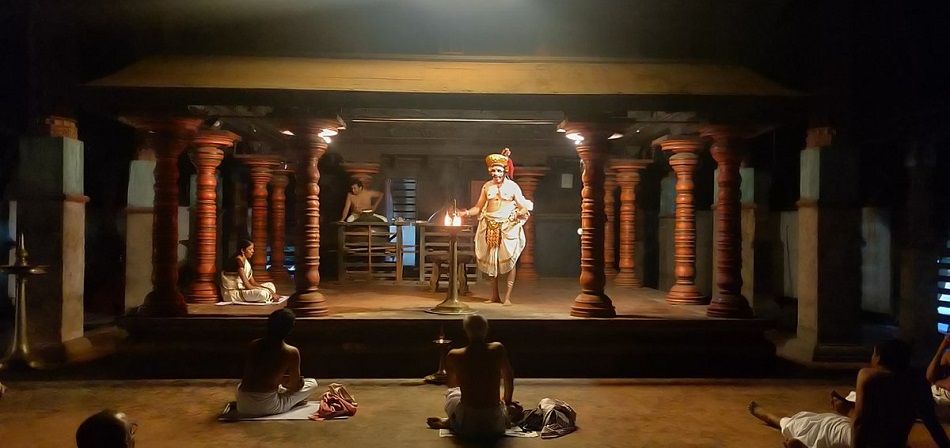As a historical monument, the architecturally exquisite Koothambalam at the Vadakkuunathan temple, tells us many interesting stories of yesteryear artists.
Thrissur Pooram held on April 23 without much fanfare had all of us holed up in our homes. The visuals on the TV screen were the only vignette to the happenings at the Thekkinkadu Maidan. Very often I was looking blank on the screen while the mind roamed in the past – the good old days when I could enjoy the Elanjithara Melam positioning myself among the group of elethalam artistes, and also standing at the middle of Madathil Varavu Panchavadyam enjoying the indescribable aural beauty of this ensemble.
Yes, I remembered. Ever since I was fascinated by Koodiyattam, some four decades ago, an insatiable surge grew inside me to visit a Koothambalam mainly because of my associations with the Ammannur family, the traditional Koodiyattam artistes and the Koodiyattam exponent G Venu. (Need not mention that Koothu and Koodiyattam are staged in the most traditional way inside the Koothambalam only) . And more, thanks to my interview with the late scholar of Sanskrit theatre Goverdhan Panchal who was ordained by Sangeet Natak Akademi (SNA) to make a detailed study of Koothambalams in Kerala, and also his monograph, “Kuttampalam & Kutiyattam” published by SNA, the end-product of his persevering task.
Published in 1984, Panchal had dedicated the book to L S Rajagopal and K P Narayana Pisharody, the doyens whose efforts in the revival of Koodiyattam are pivotal. That, Panchal, a professor of Theatre Architecture in the National School of Drama, Delhi came to know about the Koothambalams of Kerala from the Polish student of Indology, Christopher Brisky, made the story of Koothambalam more interesting.
Reminiscing great artists
Thrissur Pooram was the right occasion to visit Koothambalam since the temple is open to all irrespective of caste and creed on that day. And as the years rolled on, I turned a regular visitor to the temple precincts on the Pooram day both as a journalist and an avid rasika of the theatre form. Very often I reached the venue of the melam which is near the Koothambalam at least an hour early so that I could spend more time inside the traditional theatre. So it happened for the first time. I was alone. And myriad anecdotes began flashing on the inner eye – one after the other.
I started feeling the presence of the celebrities of yesteryears and their footprints within the four walls of this architectural marvel. Ammannur Chachu Chakyar and his satirical enquiry to the Maharaja during his koothu resounded in my ears. Need not mention, that Koothu is a solo performance by the Chakyar, the traditional performer noted his ‘vachikabhinaya’ (the verbal). He is very much the Vidushaka (jester) of Koodiyattam both in aahaarya (costumes and make-up) and antics.
Stories excerpted from Ramayana and Mahabharata are expounded very often correlating them to the contemporary events during which his wit and satire scale unimaginable heights. Chakyar’s ingenuity lies in locating characters in the episodes narrated among the audience and making them butts of ridicule and humour. In this exercise, he enjoys absolute impunity. Even Maharajas have not been spared as mentioned above.
Chachu Chakyar and Maharaja
A historic event took place nearly a century ago. The Maharaja of the erstwhile state of Cochin was regularly present in the Koothambalam to listen to Ammannur Chachu Chakyar, the supremo of his times. It is said that Maharaja was not much impressed by the narration of Chakyar in the first few days and advised him to make his vachika bitterer. On the subsequent day, Chakyar’s mainstay for the performance was a sloka from the Ramayana prabhandham that explained Ravana’s posture to Rama: “Oh Raghava, you have defeated a woman (Thataka); a Brahmin (Parasurama); a deer (Maricha) and an animal (Bali, the monkey). All this I know. What more? You have been exiled from your kingdom too”.
Every aspect of this applied directly to the Maharaja especially since he was forced to abdicate the throne by the British. And the repeated question, “Ozhinjatho, ozhippichatho” (self-abdication or a forced one?) was targeted at the king so much so that he was made to blush on the spot. But the next day the Maharaja summoned the Chakyar and congratulated him. “Your rebuke at me yesterday was splendid”, he said and presented him with a couple of onapudavas (new dhotis).
Renovating tradition
Ever since the Koothambalam was reconstructed in 1880, Chachu Chakyar himself has been instrumental in resuming the tradition of Koothu at Vadakkunnathan. However, the antiquity of the original building is still inestimable. It is believed that Perunthachan, the legendary thachan was the architect of the original Koothambalam. However, the present one is the largest among the existing ones.
I looked up and was reminded of the legendary story about the reconstruction of the building that was decaying for a long time for want of maintenance. But none of
the experts consulted would undertake the responsibility of reconstruction as it was too gigantic and complex. Finally, the authorities were helped by Velanezhi Namboodiri, a thachu sastra (traditional architecture) expert. He asked everyone to leave him alone and lay on the floor at the centre of the theatre hall, looking up for a month in meditation until he memorized every minute measurement and proportion of the entire structure. The story further goes, “The entire superstructure was dismantled and the weak parts replaced, everything got ready on the ground and the whole theatre was reassembled without a nail”.
I wonder if any rasika of the present generation regaling himself with the performances of Chakyars in the Koothambalam will care to remember these stories!


1 Comment
Hi from this blog get to know more about the Koothambalam and it is really interesting to read this blog.